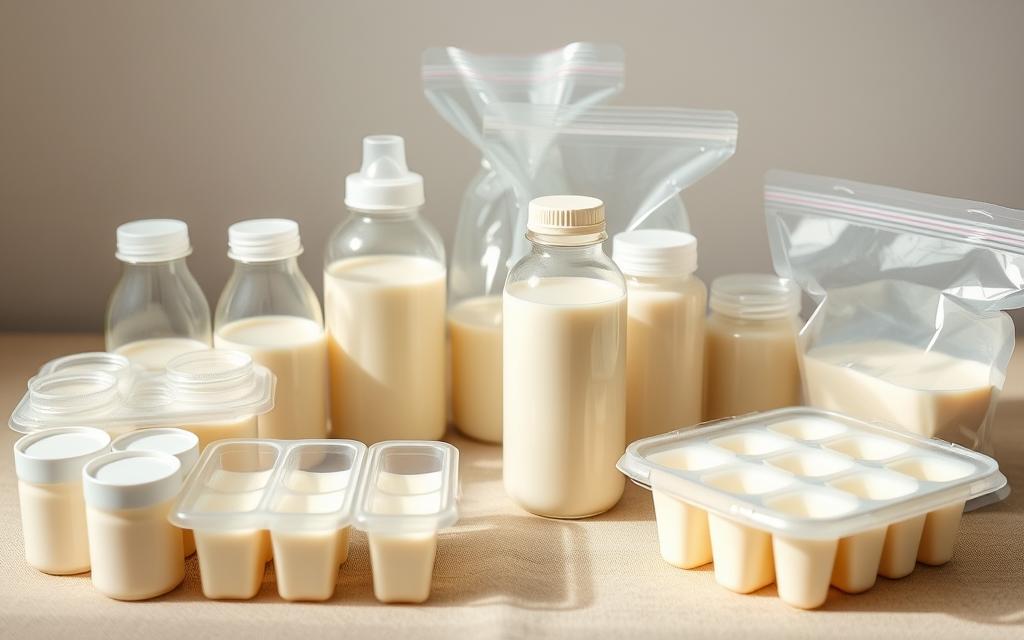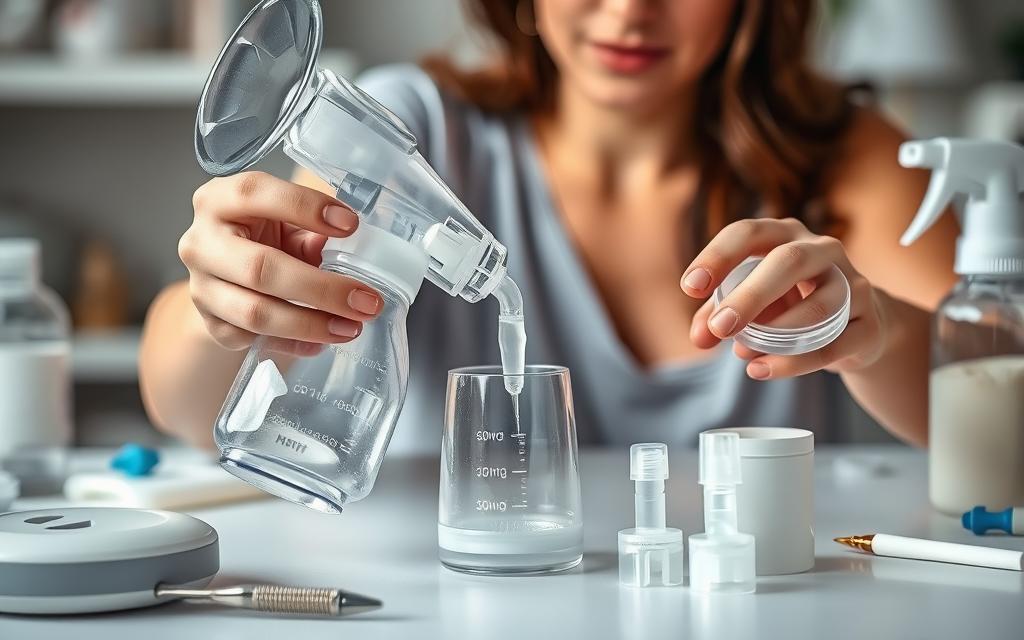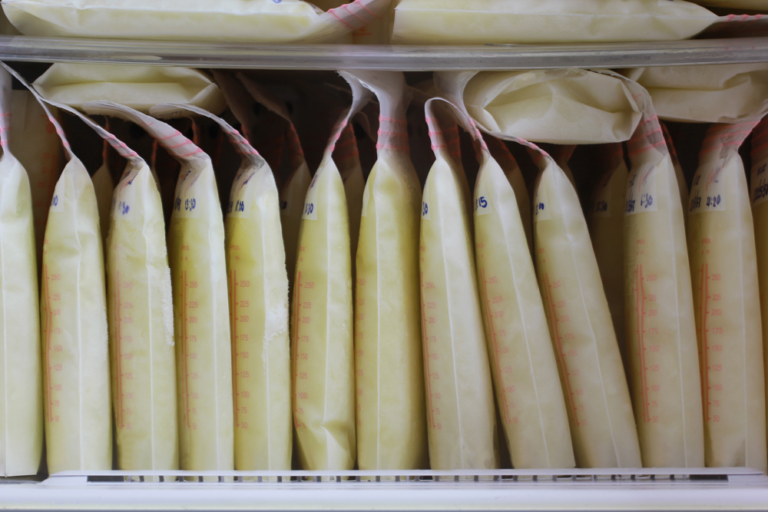How to Properly Pump and Store Breast Milk

Storing breast milk right is key to keeping it safe and nutritious for your baby. As a mom, knowing how to pump and store breast milk is vital. This guide will show you how to do it right, including tips on the right equipment and storage methods.
Key Takeaways
- Proper breast milk storage is essential for maintaining the quality and safety of the milk.
- Breast milk can be stored at room temperature for up to 4 hours, in the refrigerator for up to 4 days, and in the freezer for up to 12 months.
- When freezing breast milk, it’s recommended to store in small amounts of 2 to 4 ounces.
- Thawed breast milk should be used within 24 hours if stored in the refrigerator.
- It’s essential to follow proper pumping and storage techniques to maintain the quality of breast milk, including pumping breast milk and breast milk storage.
- Clean and sanitize all feeding and pumping equipment to protect breast milk from contamination, following CDC guidelines and best practices for breast milk storage.
- Always thaw the oldest breast milk first to maintain quality, and use it within a day of thawing, following guidelines for pumping breast milk.
Understanding the Basics of Breast Milk Expression
Breast milk expression is key for breastfeeding. It lets mothers store milk for later and ease engorgement. Mothers can choose between manual and electric pumps for this. Electric pumps are often quicker and more convenient.
Manual pumps are cheaper and easy to carry. They’re great for occasional use or for new moms. Electric pumps, though, are faster and better for regular use or large amounts of milk.
Benefits of Pumping
Pumping breast milk boosts milk supply and eases engorgement. It also lets mothers store milk for later. Pumping helps new moms build a milk supply early on. It’s also handy when moms are away from their babies, like at work.
When to Start Pumping
Mothers can pump anytime, but waiting until 4-6 weeks is often advised. This helps build a good milk supply and lets the baby adjust to breastfeeding. Some moms might need to pump sooner, like those with latching issues or needing to supplement.
Choosing between manual and electric pumps depends on what each mother needs. Electric pumps are quicker but pricier and need more upkeep. Manual pumps are cheaper, portable, but take longer to use.
It’s vital to know how to express milk safely and well. This includes keeping everything clean, storing milk right, and handling it carefully. By doing this, mothers can make sure their expressed milk is safe and healthy for their babies.
Essential Equipment for Successful Pumping
To pump milk successfully, you need the right breast milk equipment. This includes a quality pump, storage containers, and labels. A good pump is key for keeping milk safe and healthy. Look for a pump that’s comfortable, efficient, and easy to clean.
When picking a pump, think about what you need. Do you prefer a manual or electric pump? Consider the pump’s suction strength, comfort, and how easy it is to use.
Choosing the right breast milk equipment is important. Look for BPA-free, airtight storage containers. Properly labeling and dating your milk is also vital for safe storage and use.
Other important items include nursing pads, breast shields, and a special bra for hands-free pumping. The right pumping equipment can greatly improve your pumping experience. Investing in quality breast milk equipment ensures a comfortable and efficient pumping process. This makes it easier to give your baby the nutrients they need.
Preparing for Your Pumping Session
To have a successful pumping session, preparation is key. A comfortable environment is vital. It helps you relax and focus on expressing your milk. Think of a quiet, private space, a comfy chair, and a footrest.
Before you start, don’t forget to practice hand hygiene. This keeps your milk safe and of high quality. Wash your hands well with soap and water before each session. Having everything you need ready helps you stay organized and focused.
Here are some important things to think about when getting ready for your pumping session:
- Choose a private and comfy spot to pump.
- Have all your supplies, like storage bags and labels, nearby.
- Make sure to wash your hands properly to keep your milk safe.
By preparing well for your pumping session, you can make it a success. This makes it easier to give your baby the nourishment they need.
How to Pump and Store Breast Milk Properly
When pumping breast milk, getting the technique right is key. Start by placing the pump flange right over your nipple. It’s also important to keep the suction right to avoid discomfort.
Knowing how long and how often to pump is important. Most moms pump for 10-15 minutes, 2-3 times a day. But, this can change based on your needs and situation.
Storing breast milk safely is a must. Use proper suction and keep the milk in a clean, sterile place. Here are some tips for storing breast milk:
- Store breast milk in airtight containers or freezer bags
- Label the containers with the date and time of expression
- Store breast milk in the refrigerator for up to 5 days or in the freezer for up to 6 months
By following these steps and using proper suction, you can store your milk safely. This is very important for moms who store milk for later. It keeps the milk’s quality and nutritional value high.
Safe Storage Containers and Materials
Storing breast milk safely is key. Breast milk storage containers must be BPA-free, like glass or hard plastic. They should also be airtight, leak-proof, and have labels for date and time.
Options like Medela Milk Storage Bottles and Lansinoh Milk Storage Bottles are good. They’re made for breast milk and are safe. Storage bags, like Medela and Lansinoh, are also great. They’re pre-sterilized and won’t leak.
Think about your baby’s needs and your lifestyle when picking containers. If you’ll freeze milk, choose containers that can handle it. The right breast milk storage containers ensure your milk is safe and of high quality. This gives you peace of mind and confidence in feeding your baby.
Look for these features in BPA-free containers:
- Airtight and leak-proof design
- Labeling space for date and time of expression
- Freezer-safe materials
- Durable and easy to clean
By focusing on these features, you can pick the best containers. This ensures your breast milk is safe and nutritious for your baby.
Breast Milk Storage Guidelines and Temperature Requirements
Storing breast milk right is key to keeping it safe and good quality. The American Academy of Pediatrics says you can store it at room temperature, in the fridge, or in the freezer. Room temperature storage is good for a short time, while refrigeration guidelines are better for longer.
Here are some important tips to keep in mind:
- Breast milk can stay at room temperature (up to 77°F or 25°C) for up to 4 hours.
- Refrigerated breast milk should be used within 4 days at 39°F (4°C) or colder, following refrigeration guidelines.
- Breast milk can be frozen for up to 9 months in a fridge freezer at 0°F (−18°C), and up to 12 months in a chest or deep freezer at −4°F (−20°C), as part of breast milk storage guidelines.
It’s vital to follow breast milk storage guidelines to keep the milk safe and good for your baby. This means storing it in the back of the freezer, not in the door, and using the oldest milk first (FIFO) when thawing frozen milk. By sticking to these rules and room temperature storage and refrigeration guidelines, moms can make sure their breast milk stays safe and healthy for their babies.
Thawing and Using Stored Breast Milk
When thawing breast milk, it’s key to use safe methods. This keeps the milk quality and safe. Research shows thawed milk can stay at room temperature for two hours or in the fridge for 24 hours.
To thaw, you can put it in the fridge overnight or under warm running water (no hotter than 37°C or 99°F).
After thawing, warming breast milk is done by running the bottle under warm water or using a bottle warmer. Always check for signs of spoilage before feeding, like bad smells or a slimy feel. Healthy, full-term babies can drink it at room temperature or warmed to body temperature (37°C or 99°F).
- Thaw breast milk in the refrigerator or under warm running water
- Use thawed breast milk within 24 hours
- Check for signs of spoilage before feeding
- Warm breast milk to body temperature (37°C or 99°F) for feeding
Always put the safety and quality of breast milk first when thawing and using it. By following these steps, you ensure your baby gets the best nutrition.
Maintaining Your Pump and Storage Equipment
Regular pump maintenance and storage equipment maintenance are key for keeping breast milk safe and of high quality. Recent studies show that breast milk isn’t sterile. But, we must avoid contamination when pumping and storing it. It’s best to clean some parts of the pump kit after each use and sterilize them at least once a day.
To clean breast pump parts, start by rinsing them in cool water. Then, use hot, soapy water, and let them air dry. Most makers suggest boiling or sterilizing parts that touch breast milk daily. Keeping your pump well-maintained prevents contamination, ensures it works right, and makes it last longer.
Here are some tips for keeping your storage equipment in good shape:
- Clean and sanitize storage containers after each use
- Replace any worn or damaged parts
- Store breast milk in a clean and dry environment

By following these tips and doing regular pump maintenance and storage equipment maintenance, you can keep your breast milk safe and of high quality. Always follow the maker’s instructions for your pump and storage gear. If you have questions or concerns, talk to a healthcare expert.
Conclusion: Ensuring Success in Your Breast Milk Storage Journey
Storing your breast milk right is key to giving your baby the best nutrition. By following the tips in this article, you’re ready for a successful breast milk storage journey. Choosing the right gear and keeping the milk at the right temperature are important steps.
Pumping success means more than just how much milk you get. It’s also about storing it well. Proper storage keeps your milk safe and full of nutrients for your baby. With dedication and care, you’ll give your baby a great start in life.






